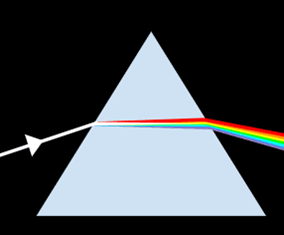Myths about teaching can hold you back


- Year 11•
- AQA•
- Foundation
Light and colour
I can describe what is different about light of different colours and explain the apparent colour of objects when illuminated with different colours of light.


- Year 11•
- AQA•
- Foundation
Light and colour
I can describe what is different about light of different colours and explain the apparent colour of objects when illuminated with different colours of light.
These resources were made for remote use during the pandemic, not classroom teaching.
Switch to our new teaching resources now - designed by teachers and leading subject experts, and tested in classrooms.
Lesson details
Key learning points
- The different colours of light are electromagnetic waves with different frequencies and wavelengths.
- A triangular prism can produce a colour spectrum from white light, showing it is a mixture of all visible wavelengths.
- From red to violet in the spectrum, frequency increases and wavelength decreases. Higher frequencies refract further.
- Opaque objects transmit no incident light. Their colour depends on which wavelengths of incident light are reflected.
- Colour filters only transmit some wavelengths. The filter colour depends on the transmitted wavelengths.
Keywords
Electromagnetic wave - Electromagnetic waves are ripples/oscillations in the invisible electric and magnetic fields that are all around us.
Frequency - The frequency of a wave is the number of oscillations that occur per second.
Wavelength - The wavelength of a wave is the distance between one point on a wave and the same point on the next wave.
Refract - Waves are said to refract when they change direction upon entering a new medium.
Opaque - An object is opaque if no light is transmitted through it.
Common misconception
Pupils assume that the colours of light will mix in the same way that paints mix.
Make it explicit in your teaching that the primary colours of light (red, green and blue) are different, and mix differently, to the primary colours of paint that pupils may have been taught elsewhere (e.g. red, yellow and blue).
To help you plan your year 11 physics lesson on: Light and colour, download all teaching resources for free and adapt to suit your pupils' needs...
To help you plan your year 11 physics lesson on: Light and colour, download all teaching resources for free and adapt to suit your pupils' needs.
The starter quiz will activate and check your pupils' prior knowledge, with versions available both with and without answers in PDF format.
We use learning cycles to break down learning into key concepts or ideas linked to the learning outcome. Each learning cycle features explanations with checks for understanding and practice tasks with feedback. All of this is found in our slide decks, ready for you to download and edit. The practice tasks are also available as printable worksheets and some lessons have additional materials with extra material you might need for teaching the lesson.
The assessment exit quiz will test your pupils' understanding of the key learning points.
Our video is a tool for planning, showing how other teachers might teach the lesson, offering helpful tips, modelled explanations and inspiration for your own delivery in the classroom. Plus, you can set it as homework or revision for pupils and keep their learning on track by sharing an online pupil version of this lesson.
Explore more key stage 4 physics lessons from the Electromagnetic waves unit, dive into the full secondary physics curriculum, or learn more about lesson planning.

Licence
Prior knowledge starter quiz
6 Questions
Q1.In a wave, the oscillations are perpendicular (at right angles) to the direction of wave travel.
Q2.Most waves happen by oscillations of particles in a substance.
Which of the following words is used to describe any substance that a wave travels through?
Q3.A sound wave has frequency 12 Hz.
Which of the following statements explains what a frequency of 12 Hz means?
Q4.Which of the following is a correct arrangement of the wave equation?
Q5.When a wave crosses a boundary from one medium to another, it …
Q6.When a light ray travels from air to glass (and is not moving at right angles to the boundary), the ray bends …
Assessment exit quiz
6 Questions
Q1.What are electromagnetic waves?
Q2.Which of the following colours of light has the lowest frequency?
Q3.White light is split into its separate colours by this triangular prism.
This is because some frequencies are more than others.


